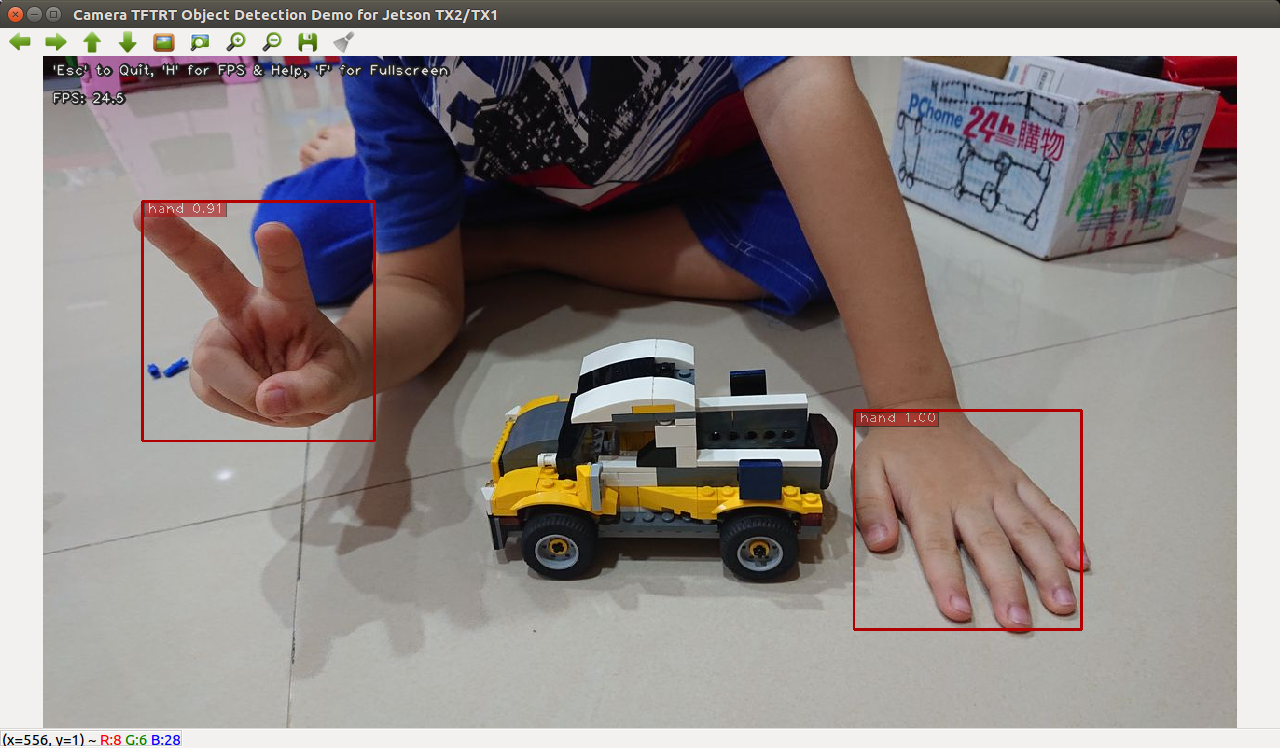Deploying the Hand Detector onto Jetson TX2
Quick link: jkjung-avt/tf_trt_models
In previous posts, I’ve shared how to apply TF-TRT to optimize pretrained object detection models, as well as how to train a hand detector with TensorFlow Object Detection API. Let’s now put things together by optimizing and deploying the hand detector on Jetson TX2.
Prerequisite
-
Follow my previous post, TensorFlow/TensorRT Models on Jetson TX2. Make sure your Jetson TX2 has been set up and could run
camera_tf_trt.pysuccessfully.Note that I’ve just fixed a couple of bugs, as well as added support for the ‘ssd_mobilenet_v1_egohands’ model, in my jkjung-avt/tf_trt_models repo. So if you have cloned the repository previously, do pull the latest code from GitHub again.
-
Follow my other post, Training a Hand Detector with TensorFlow Object Detection API. Make sure you have successfully trained the ‘ssd_mobilenet_v1_egohands’ model. We would be using the checkpoint (saved model weights) file for the demonstration below.
Changes needed from previous tf_trt_model
The following description refers to code in tf_trt_models.
-
tf_trt_modelswould need the config and checkpoint files of the ‘ssd_mobilenet_v1_egohands’ model, to be able to compile an optimized tensorflow graph for inferencing. I made a copy ofdata/ssd_mobilenet_v1_egohands.configfrom thehand-detection-tutorialrepo, while changing thescore_thresholdvalue from 1e-8 to 0.3 within. However, I did not put a copy of the model checkpoint files in the repository, since those files were too big. Please copy them over as instructed below. -
In
utils/ssd_util.py, I addedget_egohands_model()for locating the model config and checkpoint files. -
I made a copy of
data/egohands_label_map.pbtxt. This prototxt file is used for converting class IDs to class names.
Running TF-TRT optimized ssd_mobilenet_v1_egohands model on Jetson TX2
Copy your ‘ssd_mobilenet_v1_egohands’ checkpoint files from your hand-detection-tutorial to your tf_trt_models directory. For example, I have both project code checked out under my ~/project/ folder, so I’d do the following. Note that we have trained the model for a total of 20,000 steps. That’s why the checkpoint files are marked with that number.
$ cd ~/project/tf_trt_models
$ cp ~/project/hand-detection-tutorial/ssd_mobilenet_v1_egohands/model.ckpt-20000.* ./data/ssd_mobilenet_v1_egohands/
When inferencing the model with camera_tf_trt.py, you’d need to specify the label map file and set number of classes to 1. Refer to the commands below for details.
Example #1: build TensorRT optimized ‘ssd_mobilenet_v1_egohands’ model and test with a still image. I took a picture of my son’s hands along with his newly assembled LEGO car for testing. The result looked good. camera_tf_trt.py ran at ~24.5 fps in this case.
$ python3 camera_tf_trt.py --image \
--filename jk-son-hands.jpg \
--model ssd_mobilenet_v1_egohands \
--labelmap data/egohands_label_map.pbtxt \
--num-classes 1 \
--build

Example #2: verify the optimized ‘ssd_mobilenet_v1_egohands’ model with live video feed from a USB webcam. Here I myself was acting as the model in front of the webcam :-)
$ python3 camera_tf_trt.py --usb \
--model ssd_mobilenet_v1_egohands \
--labelmap data/egohands_label_map.pbtxt \
--num-classes 1

In addition to image file and USB webcam, the camera_tf_trt.py script also supports video file, IP CAM, or Jetson onboard camera as input source. I’m not going to re-iterate those here. You can refer to --help message for more details.